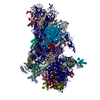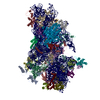+ Open data
Open data
- Basic information
Basic information
| Entry | Database: PDB / ID: 8p09 | ||||||
|---|---|---|---|---|---|---|---|
| Title | 48S late-stage initiation complex with non methylated mRNA | ||||||
 Components Components |
| ||||||
 Keywords Keywords |  TRANSLATION / TRANSLATION /  translation initiation / translation initiation /  ribosome / non methylated mRNA ribosome / non methylated mRNA | ||||||
| Function / homology |  Function and homology information Function and homology informationTranslation initiation complex formation / Formation of the ternary complex, and subsequently, the 43S complex / Ribosomal scanning and start codon recognition / Major pathway of rRNA processing in the nucleolus and cytosol / GTP hydrolysis and joining of the 60S ribosomal subunit / L13a-mediated translational silencing of Ceruloplasmin expression / SRP-dependent cotranslational protein targeting to membrane / Formation of a pool of free 40S subunits / Nonsense Mediated Decay (NMD) independent of the Exon Junction Complex (EJC) / Nonsense Mediated Decay (NMD) enhanced by the Exon Junction Complex (EJC) ...Translation initiation complex formation / Formation of the ternary complex, and subsequently, the 43S complex / Ribosomal scanning and start codon recognition / Major pathway of rRNA processing in the nucleolus and cytosol / GTP hydrolysis and joining of the 60S ribosomal subunit / L13a-mediated translational silencing of Ceruloplasmin expression / SRP-dependent cotranslational protein targeting to membrane / Formation of a pool of free 40S subunits / Nonsense Mediated Decay (NMD) independent of the Exon Junction Complex (EJC) / Nonsense Mediated Decay (NMD) enhanced by the Exon Junction Complex (EJC) /  ribosomal subunit / endonucleolytic cleavage to generate mature 3'-end of SSU-rRNA from (SSU-rRNA, 5.8S rRNA, LSU-rRNA) / endonucleolytic cleavage in ITS1 to separate SSU-rRNA from 5.8S rRNA and LSU-rRNA from tricistronic rRNA transcript (SSU-rRNA, 5.8S rRNA, LSU-rRNA) / ribosomal subunit / endonucleolytic cleavage to generate mature 3'-end of SSU-rRNA from (SSU-rRNA, 5.8S rRNA, LSU-rRNA) / endonucleolytic cleavage in ITS1 to separate SSU-rRNA from 5.8S rRNA and LSU-rRNA from tricistronic rRNA transcript (SSU-rRNA, 5.8S rRNA, LSU-rRNA) /  rough endoplasmic reticulum / regulation of translational fidelity / rough endoplasmic reticulum / regulation of translational fidelity /  translation initiation factor activity / translation initiation factor activity /  DNA-(apurinic or apyrimidinic site) lyase / small-subunit processome / DNA-(apurinic or apyrimidinic site) lyase / small-subunit processome /  ribosomal small subunit biogenesis / cytoplasmic stress granule / cytosolic small ribosomal subunit / cytoplasmic translation / ribosomal small subunit biogenesis / cytoplasmic stress granule / cytosolic small ribosomal subunit / cytoplasmic translation /  cell differentiation / cell differentiation /  ribosome / structural constituent of ribosome / ribosome / structural constituent of ribosome /  ribonucleoprotein complex / ribonucleoprotein complex /  translation / translation /  mRNA binding / mRNA binding /  synapse / synapse /  nucleolus / nucleolus /  ATP hydrolysis activity / ATP hydrolysis activity /  RNA binding / RNA binding /  ATP binding / ATP binding /  cytoplasm cytoplasmSimilarity search - Function | ||||||
| Biological species |   Oryctolagus cuniculus (rabbit) Oryctolagus cuniculus (rabbit) | ||||||
| Method |  ELECTRON MICROSCOPY / ELECTRON MICROSCOPY /  single particle reconstruction / single particle reconstruction /  cryo EM / Resolution: 3.3 Å cryo EM / Resolution: 3.3 Å | ||||||
 Authors Authors | Guca, E. / Lima, L.H.F. / Boissier, F. / Hashem, Y. | ||||||
| Funding support | European Union, 1items
| ||||||
 Citation Citation |  Journal: Mol Cell / Year: 2024 Journal: Mol Cell / Year: 2024Title: N-methyladenosine in 5' UTR does not promote translation initiation. Authors: Ewelina Guca / Rodrigo Alarcon / Michael Z Palo / Leonardo Santos / Santiago Alonso-Gil / Marcos Davyt / Leonardo H F de Lima / Fanny Boissier / Sarada Das / Bojan Zagrovic / Joseph D ...Authors: Ewelina Guca / Rodrigo Alarcon / Michael Z Palo / Leonardo Santos / Santiago Alonso-Gil / Marcos Davyt / Leonardo H F de Lima / Fanny Boissier / Sarada Das / Bojan Zagrovic / Joseph D Puglisi / Yaser Hashem / Zoya Ignatova /      Abstract: The most abundant N-methyladenosine (mA) modification on mRNAs is installed non-stoichiometrically across transcripts, with 5' untranslated regions (5' UTRs) being the least conductive. 5' UTRs are ...The most abundant N-methyladenosine (mA) modification on mRNAs is installed non-stoichiometrically across transcripts, with 5' untranslated regions (5' UTRs) being the least conductive. 5' UTRs are essential for translation initiation, yet the molecular mechanisms orchestrated by mA remain poorly understood. Here, we combined structural, biochemical, and single-molecule approaches and show that at the most common position, a single mA does not affect translation yields, the kinetics of translation initiation complex assembly, or start codon recognition both under permissive growth and following exposure to oxidative stress. Cryoelectron microscopy (cryo-EM) structures of the late preinitiation complex reveal that mA purine ring established stacking interactions with an arginine side chain of the initiation factor eIF2α, although with only a marginal energy contribution, as estimated computationally. These findings provide molecular insights into mA interactions with the initiation complex and suggest that the subtle stabilization is unlikely to affect the translation dynamics under homeostatic conditions or stress. | ||||||
| History |
|
- Structure visualization
Structure visualization
| Structure viewer | Molecule:  Molmil Molmil Jmol/JSmol Jmol/JSmol |
|---|
- Downloads & links
Downloads & links
- Download
Download
| PDBx/mmCIF format |  8p09.cif.gz 8p09.cif.gz | 1.9 MB | Display |  PDBx/mmCIF format PDBx/mmCIF format |
|---|---|---|---|---|
| PDB format |  pdb8p09.ent.gz pdb8p09.ent.gz | 1.5 MB | Display |  PDB format PDB format |
| PDBx/mmJSON format |  8p09.json.gz 8p09.json.gz | Tree view |  PDBx/mmJSON format PDBx/mmJSON format | |
| Others |  Other downloads Other downloads |
-Validation report
| Arichive directory |  https://data.pdbj.org/pub/pdb/validation_reports/p0/8p09 https://data.pdbj.org/pub/pdb/validation_reports/p0/8p09 ftp://data.pdbj.org/pub/pdb/validation_reports/p0/8p09 ftp://data.pdbj.org/pub/pdb/validation_reports/p0/8p09 | HTTPS FTP |
|---|
-Related structure data
| Related structure data |  17330MC  8p03C M: map data used to model this data C: citing same article ( |
|---|---|
| Similar structure data | Similarity search - Function & homology  F&H Search F&H Search |
- Links
Links
- Assembly
Assembly
| Deposited unit | 
|
|---|---|
| 1 |
|
- Components
Components
-RNA chain , 3 types, 3 molecules 123
| #1: RNA chain | Mass: 24376.625 Da / Num. of mol.: 1 / Source method: isolated from a natural source / Source: (natural)   Oryctolagus cuniculus (rabbit) Oryctolagus cuniculus (rabbit) |
|---|---|
| #2: RNA chain |  Mass: 601015.688 Da / Num. of mol.: 1 / Source method: isolated from a natural source / Source: (natural)   Oryctolagus cuniculus (rabbit) Oryctolagus cuniculus (rabbit) |
| #3: RNA chain |  Messenger RNA Messenger RNAMass: 2854.783 Da / Num. of mol.: 1 / Source method: isolated from a natural source / Source: (natural)   Oryctolagus cuniculus (rabbit) Oryctolagus cuniculus (rabbit) |
-Eukaryotic translation initiation factor ... , 2 types, 2 molecules Aj
| #4: Protein | Mass: 32792.867 Da / Num. of mol.: 1 / Source method: isolated from a natural source / Source: (natural)   Oryctolagus cuniculus (rabbit) / References: UniProt: G1T2G4 Oryctolagus cuniculus (rabbit) / References: UniProt: G1T2G4 |
|---|---|
| #37: Protein | Mass: 12788.764 Da / Num. of mol.: 1 / Source method: isolated from a natural source / Source: (natural)   Oryctolagus cuniculus (rabbit) / References: UniProt: G1SYS4 Oryctolagus cuniculus (rabbit) / References: UniProt: G1SYS4 |
+40S ribosomal protein ... , 25 types, 25 molecules CEGIKLMNOQRSTUVWXZabcdein
-Ribosomal protein ... , 8 types, 8 molecules DFHJPYfg
| #6: Protein |  Mass: 24944.408 Da / Num. of mol.: 1 / Source method: isolated from a natural source / Source: (natural)   Oryctolagus cuniculus (rabbit) / References: UniProt: G1TN72 Oryctolagus cuniculus (rabbit) / References: UniProt: G1TN72 |
|---|---|
| #8: Protein |  Mass: 25158.535 Da / Num. of mol.: 1 / Source method: isolated from a natural source / Source: (natural)   Oryctolagus cuniculus (rabbit) Oryctolagus cuniculus (rabbit)References: UniProt: G1TNM3,  DNA-(apurinic or apyrimidinic site) lyase DNA-(apurinic or apyrimidinic site) lyase |
| #10: Protein |  Mass: 21525.941 Da / Num. of mol.: 1 / Source method: isolated from a natural source / Source: (natural)   Oryctolagus cuniculus (rabbit) / References: UniProt: U3KMN4 Oryctolagus cuniculus (rabbit) / References: UniProt: U3KMN4 |
| #12: Protein |  Mass: 21716.387 Da / Num. of mol.: 1 / Source method: isolated from a natural source / Source: (natural)   Oryctolagus cuniculus (rabbit) / References: UniProt: G1SVB0 Oryctolagus cuniculus (rabbit) / References: UniProt: G1SVB0 |
| #18: Protein |  Mass: 17128.191 Da / Num. of mol.: 1 / Source method: isolated from a natural source / Source: (natural)   Oryctolagus cuniculus (rabbit) / References: UniProt: G1SP51 Oryctolagus cuniculus (rabbit) / References: UniProt: G1SP51 |
| #27: Protein |  Ribosome RibosomeMass: 14865.555 Da / Num. of mol.: 1 / Source method: isolated from a natural source / Source: (natural)   Oryctolagus cuniculus (rabbit) / References: UniProt: G1TG89 Oryctolagus cuniculus (rabbit) / References: UniProt: G1TG89 |
| #34: Protein |  Mass: 8358.903 Da / Num. of mol.: 1 / Source method: isolated from a natural source / Source: (natural)   Oryctolagus cuniculus (rabbit) / References: UniProt: G1SK22 Oryctolagus cuniculus (rabbit) / References: UniProt: G1SK22 |
| #35: Protein |  Mass: 34669.113 Da / Num. of mol.: 1 / Source method: isolated from a natural source / Source: (natural)   Oryctolagus cuniculus (rabbit) / References: UniProt: G1SJB4 Oryctolagus cuniculus (rabbit) / References: UniProt: G1SJB4 |
-Protein / Protein/peptide / Non-polymers , 3 types, 232 molecules kl

| #38: Protein | Mass: 66986.812 Da / Num. of mol.: 1 / Source method: isolated from a natural source / Source: (natural)   Oryctolagus cuniculus (rabbit) / References: UniProt: G1SG72 Oryctolagus cuniculus (rabbit) / References: UniProt: G1SG72 |
|---|---|
| #39: Protein/peptide |  Mass: 3473.451 Da / Num. of mol.: 1 / Source method: isolated from a natural source / Source: (natural)   Oryctolagus cuniculus (rabbit) / References: UniProt: A0A087WNH4 Oryctolagus cuniculus (rabbit) / References: UniProt: A0A087WNH4 |
| #41: Chemical | ChemComp-MG / |
-Details
| Has ligand of interest | N |
|---|
-Experimental details
-Experiment
| Experiment | Method:  ELECTRON MICROSCOPY ELECTRON MICROSCOPY |
|---|---|
| EM experiment | Aggregation state: PARTICLE / 3D reconstruction method:  single particle reconstruction single particle reconstruction |
- Sample preparation
Sample preparation
| Component | Name: 48S late-stage initiation complex with non methylated mRNA Type: RIBOSOME / Entity ID: #1-#40 / Source: NATURAL |
|---|---|
| Source (natural) | Organism:   Oryctolagus cuniculus (rabbit) Oryctolagus cuniculus (rabbit) |
| Buffer solution | pH: 7.4 |
| Specimen | Embedding applied: NO / Shadowing applied: NO / Staining applied : NO / Vitrification applied : NO / Vitrification applied : YES : YES |
Vitrification | Instrument: FEI VITROBOT MARK IV / Cryogen name: ETHANE / Humidity: 100 % / Chamber temperature: 4 K |
- Electron microscopy imaging
Electron microscopy imaging
| Experimental equipment |  Model: Talos Arctica / Image courtesy: FEI Company |
|---|---|
| Microscopy | Model: FEI TALOS ARCTICA |
| Electron gun | Electron source : :  FIELD EMISSION GUN / Accelerating voltage: 200 kV / Illumination mode: FLOOD BEAM FIELD EMISSION GUN / Accelerating voltage: 200 kV / Illumination mode: FLOOD BEAM |
| Electron lens | Mode: OTHER / Nominal defocus max: 2300 nm / Nominal defocus min: 300 nm |
| Image recording | Electron dose: 45 e/Å2 / Film or detector model: GATAN K2 QUANTUM (4k x 4k) |
- Processing
Processing
CTF correction | Type: PHASE FLIPPING AND AMPLITUDE CORRECTION |
|---|---|
3D reconstruction | Resolution: 3.3 Å / Resolution method: FSC 0.143 CUT-OFF / Num. of particles: 74515 / Symmetry type: POINT |
 Movie
Movie Controller
Controller




 PDBj
PDBj










































